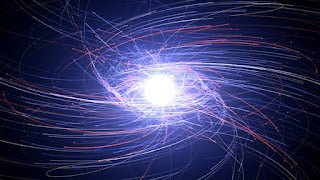5 Facts you should Know about the - Antimatter Antimatter is the stuff of science fiction. In the book and film Angels and Demons , Professor Langdon tries to save Vatican City from an antimatter bomb. Star Trek ’s starship Enterprise uses matter-antimatter annihilation propulsion for faster-than-light travel. But antimatter is also the stuff of reality. Antimatter particles are almost identical to their matter counterparts except that they carry the opposite charge and spin. When antimatter meets matter, they immediately annihilate into energy. While antimatter bombs and antimatter-powered spaceships are far-fetched, there are still many facts about antimatter that will tickle your brain cells. 2. Antimatter is closer to you than you think. Small amounts of antimatter constantly rain down on the Earth in the form of cosmic rays, energetic particles from space. These antimatter particles reach our atmosphere at a rate ranging from less than one per square met...
5 Facts you should Know about the - Antimatter
Antimatter is the stuff of science fiction. In the book and film Angels and Demons, Professor Langdon tries to save Vatican City from an antimatter bomb. Star Trek’s starship Enterprise uses matter-antimatter annihilation propulsion for faster-than-light travel.
But antimatter is also the stuff of reality. Antimatter particles are almost identical to their matter counterparts except that they carry the opposite charge and spin. When antimatter meets matter, they immediately annihilate into energy.
While antimatter bombs and antimatter-powered spaceships are far-fetched, there are still many facts about antimatter that will tickle your brain cells.
2. Antimatter is closer to you than you think.
Small amounts of antimatter constantly rain down on the Earth in the form of cosmic rays, energetic particles from space. These antimatter particles reach our atmosphere at a rate ranging from less than one per square meter to more than 100 per square meter. Scientists have also seen evidence of antimatter production above thunderstorms.
But other antimatter sources are even closer to home. For example, bananas produce antimatter, releasing one positron—the antimatter equivalent of an electron—about every 75 minutes. This occurs because bananas contain a small amount of potassium-40, a naturally occurring isotope of potassium. As potassium-40 decays, it occasionally spits out a positron in the process.
Our bodies also contain potassium-40, which means positrons are being emitted from you, too. Antimatter annihilates immediately on contact with matter, so these antimatter particles are very short-lived.
3. Humans have created only a tiny amount of antimatter.
Antimatter-matter annihilations have the potential to release a huge amount of energy. A gram of antimatter could produce an explosion the size of a nuclear bomb. However, humans have produced only a minuscule amount of antimatter.
All of the antiprotons created at Fermilab’s Tevatron particle accelerator add up to only 15 nanograms. Those made at CERN amount to about 1 nanogram. At DESY in Germany, approximately 2 nanograms of positrons have been produced to date.
If all the antimatter ever made by humans were annihilated at once, the energy produced wouldn’t even be enough to boil a cup of tea.
The problem lies in the efficiency and cost of antimatter production and storage. Making 1 gram of antimatter would require approximately 25 million billion kilowatt-hours of energy and cost over a million billion dollars
4. There is such a thing as an antimatter trap.
To study antimatter, you need to prevent it from annihilating with matter. Scientists have created ways to do just that.
Charged antimatter particles such as positrons and antiprotons can be held in devices called Penning traps. These are comparable to tiny accelerators. Inside, particles spiral around as the magnetic and electric fields keep them from colliding with the walls of the trap.
But Penning traps won’t work on neutral particles such as antihydrogen. Because they have no charge, these particles cannot be confined by electric fields. Instead, they are held in Ioffe traps, which work by creating a region of space where the magnetic field gets larger in all directions. The particle gets stuck in the area with the weakest magnetic field, much like a marble rolling around the bottom of a bowl.
Earth’s magnetic field can also act as a sort of antimatter trap. Antiprotons have been found in zones around the Earth called Van Allen radiation belts.
5. Antimatter might fall up.
Antimatter and matter particles have the same mass but differ in properties such as electric charge and spin. The Standard Model predicts that gravity should have the same effect on matter and antimatter; however, this has yet to be seen. Experiments such as AEGIS, ALPHA and GBAR are hard at work trying to find out.
Observing gravity’s effect on antimatter is not quite as easy as watching an apple fall from a tree. These experiments need to hold antimatter in a trap or slow it down by cooling it to temperatures just above absolute zero. And because gravity is the weakest of the fundamental forces, physicists must use neutral antimatter particles in these experiments to prevent interference by the more powerful electrical force.





Comments
Post a Comment